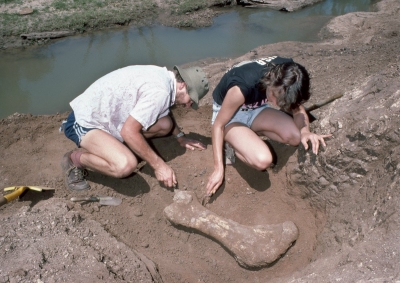
|
The age of a fossil is gauged by what is called radiometric, carbon-14 dating, which measures changes in its atomic structure. But carbon-14 cannot date fossils older than 50,000 years, such as those of dinosaurs. To date such fossils, other types of radiometric dating are used that calculate the age of the rocks above and below the sedimentary rock in which such a fossil was found. |
When examining remnants from the past, experts use radiometric dating, a versatile technique that involves counting radioactive atoms of certain elements that are still present in a sample. The particular elements studied, as well as the details of the process, depend on the approximate age of the object that scientists hope to date.
For human or animal remains and artifacts from the past 50,000 years or so, researchers look at levels of carbon 14 in the sample. Also called “radiocarbon,” this isotope is generated by cosmic rays colliding with nitrogen in Earth’s atmosphere, says José Capriles, an archaeologist at Pennsylvania State University. Chemically, carbon 14 behaves exactly like its stable siblings (carbon 12 and carbon 13), allowing plants to absorb it during photosynthesis and then pass it up the food chain. While alive, animals and plants tend to contain the same levels of carbon 14 as their environment. But “as living organisms die, they stop consuming or incorporating radiocarbon,” Capriles says, and “the process of radioactivity kicks in,” with the isotope decaying back into nitrogen. So researchers compare the amount of carbon 14 with the levels of carbon 12 and carbon 13 to determine how much time has passed since an organism perished.
Credit: Scientific American
Picture Credit : Google




